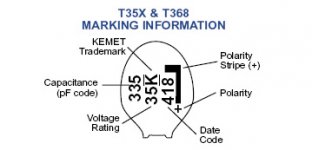Not a stupid question Puffin, but a silly thread title! 😉
Remember when the next person comes looking for an answer to the same question, it helps to be able to see the subject in the thread title. "Stupid question" doesn't tell us anything but "Tantalum capacitor polarity question" speaks volumes!
Remember when the next person comes looking for an answer to the same question, it helps to be able to see the subject in the thread title. "Stupid question" doesn't tell us anything but "Tantalum capacitor polarity question" speaks volumes!

Correct, right legs in your pictures are positive (+) leads.
- most tantalum capacitor marking/bar indicate positive (+) lead
- which is opposite to most aluminum electrolytics, where marking/bar indicate negative (-) lead
Typical dipped tantalum marking, lifted from KEMET literature below.
See page 63, KEMET dipped tantalum:
http://www.kemet.com/kemet/web/homepage/kechome.nsf/weben/295473B721A819ECCA2570A50016090E/$file/F3100_TaDipRad.pdf
ps: no such thing as a stupid question...
- most tantalum capacitor marking/bar indicate positive (+) lead
- which is opposite to most aluminum electrolytics, where marking/bar indicate negative (-) lead
Typical dipped tantalum marking, lifted from KEMET literature below.
See page 63, KEMET dipped tantalum:
http://www.kemet.com/kemet/web/homepage/kechome.nsf/weben/295473B721A819ECCA2570A50016090E/$file/F3100_TaDipRad.pdf
ps: no such thing as a stupid question...
Attachments
Puffin,
Yes, stupid thread title!
Go and ask, nicely, if the mods will retitle your thread for us.
Yes, stupid thread title!
Go and ask, nicely, if the mods will retitle your thread for us.
Just my 2 cents here:
In many electronic parts, the longer lead is the positive lead (provided that they are unclipped). This is true for both tants and normal electrolytics.
Better be safe than sorry: tants can pop nastily if they are connected in reverse polarity, so there's no need to be ashamed for checking before mouting them!
In many electronic parts, the longer lead is the positive lead (provided that they are unclipped). This is true for both tants and normal electrolytics.
Better be safe than sorry: tants can pop nastily if they are connected in reverse polarity, so there's no need to be ashamed for checking before mouting them!
AndrewT said:Puffin,
Yes, stupid thread title!
Go and ask, nicely, if the mods will retitle your thread for us.
What did I say to upset you?
I have stopped using tantal caps, I have seen several cases where they go completely short circuit for no reason. I read somewhere that this is common. Something to do with the chemical contents. They are very sensitive to reverse polarity indeed.
So, if I want to substitute a tant, I use a regular electrolytic and a MKP or similar in parallell.
So, if I want to substitute a tant, I use a regular electrolytic and a MKP or similar in parallell.
Rikard Nilsson said:I have stopped using tantal caps, I have seen several cases where they go completely short circuit for no reason. I read somewhere that this is common. Something to do with the chemical contents. They are very sensitive to reverse polarity indeed.
So, if I want to substitute a tant, I use a regular electrolytic and a MKP or similar in parallell.
It's not so common, I've hundreds of old computer components using tantalums with zero failures and have often put them in old amp projects that never failed.
The main problem is when someone self-designs something and doesn't leave enough margin. For example, if you have a 14V circuit you might accept using a 16V electrolytic but you'd be wise to step up to a 20-25V tantalum.
Reverse polarity is a different matter, they'll destroy themselves right away.
Having said "Yes", do you really want me to repeat the above?Nuuk said:Not a stupid question Puffin, but a silly thread title! 😉
Remember when the next person comes looking for an answer to the same question, it helps to be able to see the subject in the thread title. "Stupid question" doesn't tell us anything but "Tantalum capacitor polarity question" speaks volumes!
- Status
- Not open for further replies.
- Home
- Amplifiers
- Chip Amps
- Tantalum capacitor polarization?

